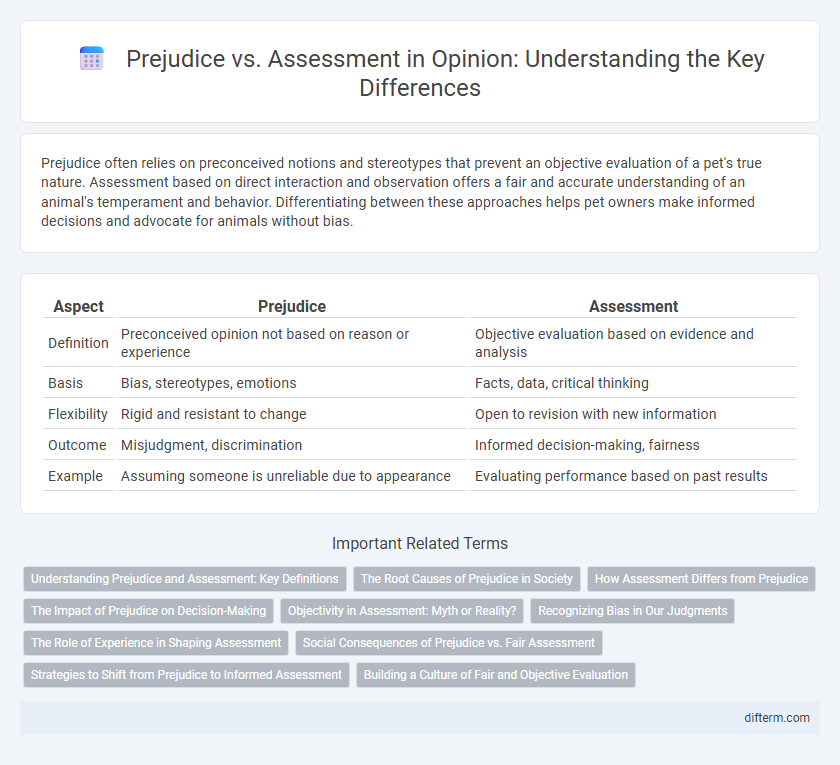Prejudice often relies on preconceived notions and stereotypes that prevent an objective evaluation of a pet's true nature. Assessment based on direct interaction and observation offers a fair and accurate understanding of an animal's temperament and behavior. Differentiating between these approaches helps pet owners make informed decisions and advocate for animals without bias.
Table of Comparison
| Aspect | Prejudice | Assessment |
|---|---|---|
| Definition | Preconceived opinion not based on reason or experience | Objective evaluation based on evidence and analysis |
| Basis | Bias, stereotypes, emotions | Facts, data, critical thinking |
| Flexibility | Rigid and resistant to change | Open to revision with new information |
| Outcome | Misjudgment, discrimination | Informed decision-making, fairness |
| Example | Assuming someone is unreliable due to appearance | Evaluating performance based on past results |
Understanding Prejudice and Assessment: Key Definitions
Prejudice involves preconceived judgments often based on stereotypes and emotions rather than objective facts, leading to biased attitudes toward individuals or groups. Assessment refers to the systematic evaluation of information or evidence to form reasoned conclusions without allowing personal biases to interfere. Understanding the distinction between prejudice and assessment is crucial for promoting fairness and accurate judgment in social interactions and decision-making processes.
The Root Causes of Prejudice in Society
Prejudice often stems from deep-seated fears and ignorance, linked to social conditioning and lack of exposure to diversity. Assessment requires critical thinking and factual evaluation, which counters biases ingrained through stereotypes and misinformation. Understanding the root causes of prejudice involves addressing economic inequality, cultural segregation, and educational deficits that perpetuate misunderstanding.
How Assessment Differs from Prejudice
Assessment relies on objective evidence and critical analysis to form conclusions, whereas prejudice stems from biased assumptions and unfounded judgments. Assessments evolve with new information, promoting fairness and accuracy, while prejudice remains rigid and resistant to change. This fundamental difference highlights how assessment fosters informed decision-making, contrasting sharply with the subjective nature of prejudice.
The Impact of Prejudice on Decision-Making
Prejudice can significantly distort decision-making processes by introducing unconscious biases that overshadow objective assessment, leading to unfair judgments and missed opportunities. Research shows that individuals influenced by prejudice often rely on stereotypes rather than fact-based evaluation, compromising the quality of decisions in professional and social contexts. Mitigating prejudice through awareness and structured decision-making frameworks improves accuracy and promotes equity in outcomes.
Objectivity in Assessment: Myth or Reality?
Objectivity in assessment is often perceived as a standard of fairness, yet true impartiality is challenged by inherent cognitive biases and contextual influences. While methodologies strive to minimize subjective distortions, complete neutrality remains elusive due to individual perspectives shaping interpretation. Recognizing these limitations is crucial for developing more balanced evaluation frameworks that acknowledge inherent biases while pursuing greater accuracy.
Recognizing Bias in Our Judgments
Recognizing bias in our judgments requires a conscious effort to separate preconceived notions from objective assessments, enhancing fairness and accuracy in decision-making. Prejudice often distorts perception by filtering information through stereotypes, while unbiased assessment values evidence and individual merits. Developing awareness of cognitive biases such as confirmation bias and implicit bias is essential for fostering impartial evaluations and reducing discriminatory practices.
The Role of Experience in Shaping Assessment
Experience plays a crucial role in shaping assessment by providing concrete evidence that challenges or confirms preconceived notions, allowing for more accurate and individualized evaluations. Unlike prejudice, which is based on unfounded biases, assessments grounded in experience rely on observable interactions and outcomes, leading to informed judgments. The depth and diversity of experiences enhance one's ability to discern subtle nuances, reducing the likelihood of unfair stereotyping and promoting critical thinking.
Social Consequences of Prejudice vs. Fair Assessment
Prejudice often leads to social exclusion, discrimination, and entrenched inequalities, undermining community cohesion and trust. Fair assessment promotes equitable opportunities, fostering inclusivity and mutual respect across diverse social groups. Addressing prejudice through unbiased evaluation enhances social justice and reduces systemic disparities.
Strategies to Shift from Prejudice to Informed Assessment
Implementing strategies like active listening, seeking diverse perspectives, and engaging in critical self-reflection helps shift from prejudice to informed assessment. Emphasizing evidence-based evaluation and suspending immediate judgments encourages impartial understanding. Training in empathy development and cognitive bias awareness supports more accurate, fair assessments.
Building a Culture of Fair and Objective Evaluation
Building a culture of fair and objective evaluation requires prioritizing unbiased assessment over prejudice, ensuring decisions are based on observable performance and concrete criteria. Emphasizing transparent processes and clear standards reduces the influence of personal biases and fosters trust within organizations. Cultivating awareness and continuous training on implicit bias strengthens commitment to equitable treatment and merit-based outcomes.
prejudice vs assessment Infographic

 difterm.com
difterm.com